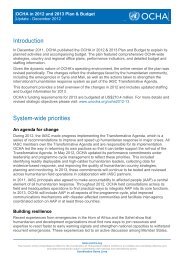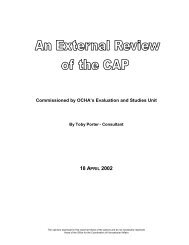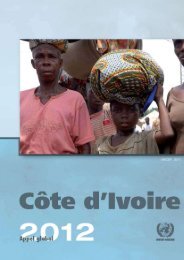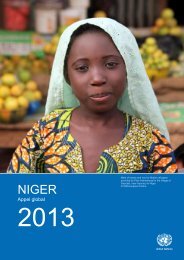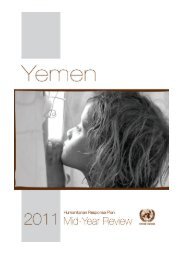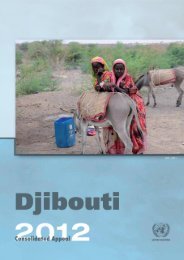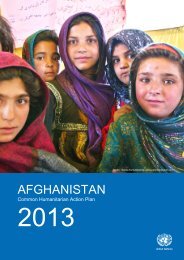Table of contents
Untitled
Untitled
You also want an ePaper? Increase the reach of your titles
YUMPU automatically turns print PDFs into web optimized ePapers that Google loves.
24[2] PROGRESS | STRATEGIC PRIORITIES United Nations and PartnersSUDAN WORK PLAN 2012strategic priorities1Contributeto timelyand effective humanitarianresponse throughoutSudan.The humanitarian community continues to make a significantcontribution to meet humanitarian needs in Sudan. Some 2.1million people have benefitted so far from emergency assistanceprovided for in the 2012 HWP. The assistance providedby humanitarian actors is crucial in meeting these needs,complementing or augmenting assistance provided by theGovernment or Sudanese organisations. The table belowshows that sectors are largely on track with their objectivesrelated to this overall strategic priority.However, a number <strong>of</strong> obstacles have been encountered interms <strong>of</strong> meeting this strategic priority. These relate primarilyto the decreased levels <strong>of</strong> funding available for humanitarianpartners, as well as access constraints impeding partner’s abilityto reach vulnerable populations. Moreover, severe restrictionsare imposed on international humanitarian actors toindependently assess and undertake humanitarian actions inconflict-affected areas. As discussed in the previous section,there has been a significant reduction in funding available forhumanitarian action which has forced many organizations tosuspend projects and scale back activities.em%afàSector Sector objective corresponding to strategic priority ProgressBICCSEDUFSLHMAEnsure access to at-risk populations (women, men, youthand children)- by repairing, rehabilitating and constructingtransportation networks (roads, airstrips, bridges and rivertransport).Improve the overall operating environment for humanitariansthrough advocacy and strengthened coordination.Improve the efficiency <strong>of</strong> humanitarian programs by providingcommon services that reduce indirect costs throughincreased access to the humanitarian pooled funds, commontransport services, expansion <strong>of</strong> mapping services and provision<strong>of</strong> security advice and support.Increase access to basic education for the most disadvantagedand vulnerable pre-school and primary school-agechildren (including IDPs, returnees, refugees, nomads andhost/rural underserved, especially girls).Improve quality <strong>of</strong> education and learning experience inconducive learning environments for the most disadvantagedand vulnerable pre-school and basic education school-agedchildren (including IDPs, returnees and refugee children,nomads, especially girls).Reduce acute food insecurity and save lives <strong>of</strong> vulnerablepeople.To contribute towards better access for vulnerable populationsto quality primary and secondary health care services.To contribute to a reduction in maternal and child morbidityand mortality focusing on safe motherhood and child survivalinterventions.To facilitate free and safe movement for humanitarian operationsthrough clearance <strong>of</strong> landmines and explosive remnants<strong>of</strong> war (ERW).To reduce the risk <strong>of</strong> injury from landmines and ERW andfacilitate the reintegration <strong>of</strong> victims through targeted minerisk education (MRE) and victim assistance interventions.Major GapsOn TrackOn TrackMinor GapsMinor GapsOn TrackOn TrackOn TrackMajor GapsOn TrackbhjEEkSector Sector Objective corresponding to Strategic Priority ProgressNFIs/ESNUTPROREFRERWASH2PromoteProvide needs-based and timely non-food items (NFI andemergency shelter to people affected by conflict and disaster,returnees, and other vulnerable populations.Facilitate coordination, timely information sharing, andcapacity-building amongst all partners and stakeholders inthe sector.Contribute to improved access to acceptable quality <strong>of</strong>prevention, care, and treatment <strong>of</strong> acute malnutrition forpopulations with critical nutrition situations or conflictaffected areas.Enhance protection <strong>of</strong> civilians and promote the realization<strong>of</strong> their rights.Ensure effective protection for refugees and asylum seekerswith particular attention to vulnerable groups.Refugees have access to basic needs and essentials services.Provide timely and coordinated humanitarian response tovulnerable IDP populations returning to areas <strong>of</strong> intendedsettlement.Sustain and expand access to safe water supply for underservedand vulnerable population in areas affected byconflict, flood, drought and disease outbreaks, returnees andin rural areas.Sustain and expand access to improved sanitation forunder-served and vulnerable population in areas affected byconflict, flood, drought and disease outbreaks, returnees andin rural areas.Reach out with hygiene education for under-served andvulnerable population in areas affected by conflict, flood,drought and disease outbreaks, returnees and in rural areas.On TrackOn TrackOn TrackMinor GapsOn TrackMinor GapsOn TrackOn TrackOn TrackOn Trackand facilitatedurable solutions, empoweringpeople by reducingaid dependenceSome progress has been made towards promoting and facilitatingdurable solutions during 2012. At the policy level, a keypart <strong>of</strong> this has been the humanitarian community coming toa shared understanding <strong>of</strong> the need to pursue durable solutionsin the broader context <strong>of</strong> a gradual transition to recoveryand development activities where possible. The HumanitarianCountry Team (HCT) is developing a framework <strong>of</strong> principlesto guide the overall approach to be shared with authorities.At the operational level, it is obvious that many sectors arebeginning the transition to early recovery activities as part<strong>of</strong> rationalizing their approach to assistance in Darfur. Moreover,many organizations already base their assistance on theprinciples <strong>of</strong> augmenting self-reliance and promoting sustainability.What is <strong>of</strong> concern, however, is the lack <strong>of</strong> fundingtowards humanitarian projects that promote sustainable livelihoodsactivities since building livelihoods is a corner stone fordurable solutions. Without a concomitant scale up <strong>of</strong> activitiesaimed at livelihoods and increasing the resilience <strong>of</strong> peoplein areas such as Darfur, it is unlikely that gains made in terms<strong>of</strong> rationalizing and changing the direction <strong>of</strong> the aid operationin Darfur can be sustained. This challenge is seen in thetable below, where many sectors have recorded major gaps inreaching their objectives.




